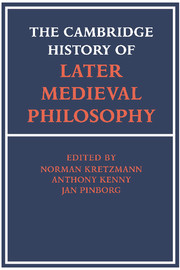 The Cambridge History of Later Medieval Philosophy
The Cambridge History of Later Medieval Philosophy Book contents
- Frontmatter
- Introduction
- I Medieval philosophical literature
- II Aristotle in the middle ages
- III The old logic
- IV Logic in the high middle ages: semantic theory
- V Logic in the high middle ages: propositions and modalities
- 14 Topics: their development and absorption into consequences
- 15 Consequences
- 16 Obligations
- 17 Modal logic
- 18 Future contingents
- VI Metaphysics and epistemology
- VII Natural philosophy
- VIII Philosophy of mind and action
- IX Ethics
- X Politics
- XI The defeat, neglect, and revival of scholasticism
- Index nominum
- Index rerum
- References
17 - Modal logic
from V - Logic in the high middle ages: propositions and modalities
Published online by Cambridge University Press: 28 March 2008
- Frontmatter
- Introduction
- I Medieval philosophical literature
- II Aristotle in the middle ages
- III The old logic
- IV Logic in the high middle ages: semantic theory
- V Logic in the high middle ages: propositions and modalities
- 14 Topics: their development and absorption into consequences
- 15 Consequences
- 16 Obligations
- 17 Modal logic
- 18 Future contingents
- VI Metaphysics and epistemology
- VII Natural philosophy
- VIII Philosophy of mind and action
- IX Ethics
- X Politics
- XI The defeat, neglect, and revival of scholasticism
- Index nominum
- Index rerum
- References
Summary
Two notions of possibility
For Aristotle the term ‘possibility’ is homonymous (Pr. An. I, 3, 25a37–40): on some occasions the possible and the impossible are contradictories (e.g., De int. 12, 22a11–13; 13, 22a32–38), while on others possibility is incompatible not only with impossibility but also with necessity (e.g., An. pr. I, 13, 32a18–21). Whenever the distinction is relevant, I shall call possibility in the first sense ‘possibility proper’ and possibility in the second sense ‘contingency’.
In the Latin translation of De interpretatione by Marius Victorinus which was used by Boethius Aristotle's two terms for ‘possible’ were translated by the Latin terms ‘ possible’ and ‘ contingens’, which Boethius understood to be synonyms. This was the usual view in early medieval logic, and it can still be found in the squares of opposition for modalities presented by William of Sherwood and Peter of Spain in the middle of the thirteenth century. Already in the twelfth century, however, there were attempts to give separate meanings to the two words. For instance, John of Salisbury criticised those who used the terms as synonyms; according to usage in his time a mere absence of impossibility did not warrant calling something contingent. Even in those works in which the terms are used as synonyms there often is a remark referring to a related distinction, according to which ‘contingens’ is opposed to ‘necessarium’ in the sense that some possible sentences are necessary and others contingent. This became the dominant use of the words in later medieval logic.
Information
- Type
- Chapter
- Information
- The Cambridge History of Later Medieval PhilosophyFrom the Rediscovery of Aristotle to the Disintegration of Scholasticism, 1100–1600, pp. 342 - 357Publisher: Cambridge University PressPrint publication year: 1982
References
Accessibility standard: Unknown
Why this information is here
This section outlines the accessibility features of this content - including support for screen readers, full keyboard navigation and high-contrast display options. This may not be relevant for you.Accessibility Information
- 13
- Cited by